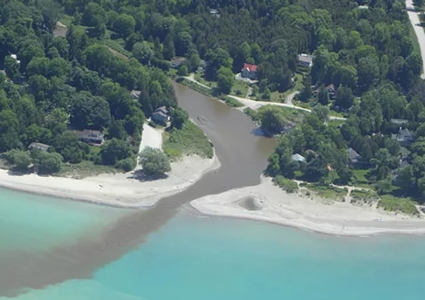Pledging
These are the original issues in this subcategory

You May Pledge Your Support For This Issue With A Monetary
Donation And By Writing A Letter To Your Representatives
- EMERGING CONTAMINANTS
- PLASTIC POLLUTION
- NONPOINT SOURCE POLLUTION

Nonpoint source pollution (NPS) refers to the presence of untraceable sources of contaminants in a polluted water supply. This pollution is often caused by rainfall or snowmelt moving over and through the ground. This runoff often picks up pollutants as it migrates, depositing it into rivers, lakes, wetlands and coastal waters. Some nonpoint source pollutants include runoff from farm fertilizers and pesticides, waste from animal feedlots and aquafarms, acid mine drainage, and oils and salts from our roadways which are washed into city storm drains.
As the sources of NPS are widely varied, so are its solutions. Urban solutions include the use of porous pavement and buffer strips of grass or dirt barriers placed between paved surfaces and the closest body of water. These measures allow the soil to absorb contaminants from stormwater before it enters a waterway. Retention ponds can also be built in drainage areas to catch stormwater runoff, allowing contaminates to settle out and become trapped in the ponds. Farmers can utilize erosion controls to reduce runoff and retain soil on their fields. Common techniques include contour plowing, crop mulching, crop rotation and planting perennial crops. Farmers can better manage their use of fertilizers to reduce excessive application of these nutrients. They can also employ integrated pest management techniques, including biological pest control, to reduce their use of chemical pesticides.
Proposed Legislation: Reintroduction of S.29 - Local Water Protection Act (117th Congress 2021-2022)
Prospective Sponsor: Sen. Amy Klobuchar (MN)
Tweet
As the sources of NPS are widely varied, so are its solutions. Urban solutions include the use of porous pavement and buffer strips of grass or dirt barriers placed between paved surfaces and the closest body of water. These measures allow the soil to absorb contaminants from stormwater before it enters a waterway. Retention ponds can also be built in drainage areas to catch stormwater runoff, allowing contaminates to settle out and become trapped in the ponds. Farmers can utilize erosion controls to reduce runoff and retain soil on their fields. Common techniques include contour plowing, crop mulching, crop rotation and planting perennial crops. Farmers can better manage their use of fertilizers to reduce excessive application of these nutrients. They can also employ integrated pest management techniques, including biological pest control, to reduce their use of chemical pesticides.
Proposed Legislation: Reintroduction of S.29 - Local Water Protection Act (117th Congress 2021-2022)
Prospective Sponsor: Sen. Amy Klobuchar (MN)
Tweet
- I oppose reforming current nonpoint source pollution policy and wish to donate resources to the campaign committee of Leader Charles Schumer (NY).
- I support reauthorizing through 2022 grants to states for: 1.) Programs that manage and control pollution added from nonpoint sources to navigable waters. 2.) Groundwater quality protection activities to advance state implementation of such programs. And wish to donate resources to the campaign committee of Sen. Amy Klobuchar (MN) and/or to an advocate group currently working with this issue.
- I support reauthorizing through 2022 grants to states for:
1.) Programs that manage and control pollution added from nonpoint sources to navigable waters.
2.) Groundwater quality protection activities to advance state implementation of such programs.
And wish to donate resources to the campaign committee of Sen. Amy Klobuchar (MN) and/or to an advocate group currently working with this issue.
Donation And By Writing A Letter To Your Representatives
Please login to pledge
Pledge Period - Opening Date
December 16, 2024
Pledge Period - Closing Date
December 22, 2024
Trustee Election - Begins
December 23, 2024
Suggest a worthy trustee for consideration before Day 16 of this presentation cycle. (Maximum 60 Characters)